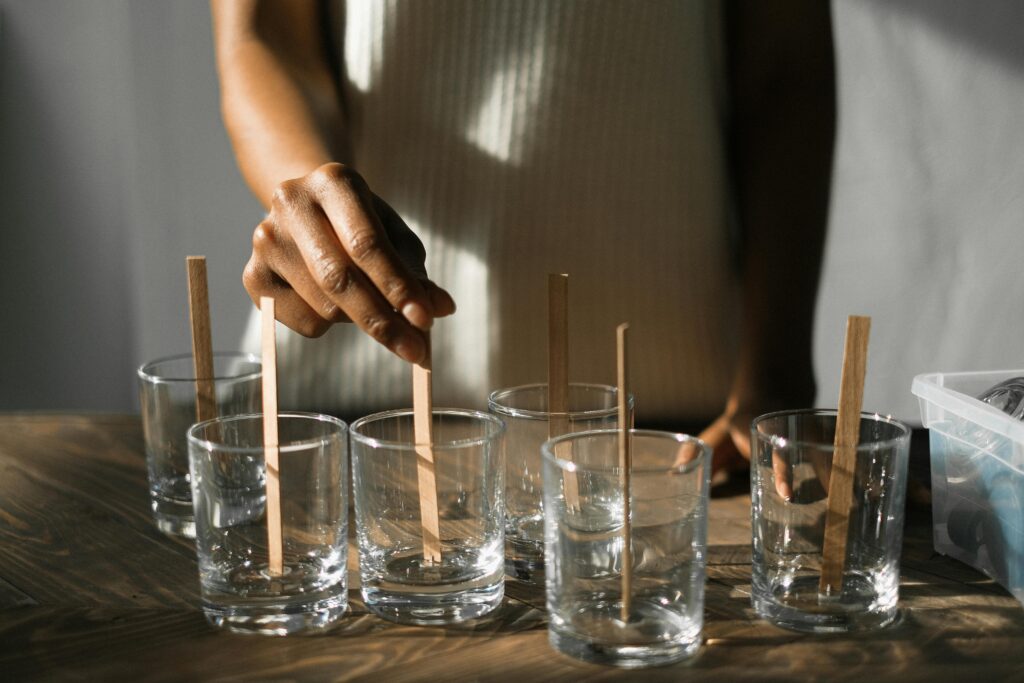Candle making mistakes can be easily avoided with a little know-how. Candle making is a fun and rewarding craft that allows you to create beautiful, one-of-a-kind candles right at home. Whether you’re making candles for yourself or planning to sell them, it’s an enjoyable process that can be incredibly satisfying.
If you’re new to candle making, understanding what to avoid can make all the difference in achieving great results. By learning a few simple tips, you can save time, avoid frustration, and create stunning candles every time!
In this post, we’ll go over the top 10 candle making mistakes and how to avoid them, so you can create perfect candles every time. Whether you’re using soy wax, paraffin wax, or beeswax, these tips will help you get the best results.
1. Using the Wrong Type of Wax
One of the biggest mistakes in candle making is choosing the wrong type of wax. Different waxes have different properties, which affect how your candles burn, how they hold fragrance, and even their appearance. Soy wax, paraffin wax, beeswax, and palm wax are all popular options, but each one behaves differently. My favorite is soy wax and it’s the only type I use.
How to Avoid This Mistake:
- Choose a wax that suits your needs. Soy wax is a great option for beginners as it’s easy to work with and burns cleanly. Beeswax creates beautiful, natural candles but can be harder to work with.
- If you’re making scented candles, ensure the wax you use has a high fragrance load capacity. Soy wax is a good choice for fragrance retention.
2. Not Measuring the Temperature Correctly
Candle making involves a delicate balance of heat. If the wax is too hot or too cool, your candles may not set correctly or could crack. Not monitoring the temperature of your wax is one of the most common candle making mistakes.
How to Avoid This Mistake:
- Always use a thermometer to measure the temperature of your wax. Most waxes should be melted to around 170°F (77°C) before adding fragrance oils. Let the wax cool slightly before pouring, typically between 130°F (54°C) and 140°F (60°C).
- Make sure to check the specific temperature recommendations for the wax you’re using.
3. Overheating the Wax
Overheating your wax can cause it to break down and lose its fragrance or color. In extreme cases, it can even cause the wax to burn or catch fire. It’s essential to follow the recommended temperature guidelines for your chosen wax.
How to Avoid This Mistake:
- Never heat wax above 185°F (85°C). Always heat it slowly and monitor the temperature with a thermometer.
- Use a double boiler to melt your wax, ensuring it doesn’t come into direct contact with the heat source.
4. Adding Fragrance Oil at the Wrong Temperature
Adding fragrance oils to wax is one of the most exciting parts of candle making, but it’s also easy to get wrong. If you add fragrance oils at the wrong temperature, they may not properly bind with the wax, leading to weak or inconsistent scent throw. Also, always make sure to use quality fragrance oils from reputable suppliers, like CandleScience and Candles and Supplies.
How to Avoid This Mistake:
- Wait until your wax has cooled to around 170°F (77°C) before adding fragrance oils. This ensures that the fragrance binds with the wax without evaporating.
- Be sure to use the right amount of fragrance oil. Most waxes hold about 6-10% fragrance, but this can vary, so always check the manufacturer’s guidelines.
5. Using Poor-Quality Wicks
The wick is one of the most important elements in candle making. If the wick is too large or too small for your candle, it will affect the burn time and even cause the candle to tunnel or flicker.
How to Avoid This Mistake:
- Choose the right wick for the size and type of your candle. Cotton, wood, and hemp wicks all have different burn characteristics. If your wick is too large, your candle may burn too hot and cause the wax to melt unevenly.
- Test wicks before you make a batch. Testing different wicks ensures you get the right one for your candles, and it’s an essential step to avoid problems like excess soot or incomplete burning.
6. Not Preparing the Containers or Molds Properly
Another mistake many candle makers make is failing to properly prepare their molds or containers. If you don’t clean your containers or molds before pouring the wax, it can cause issues like uneven surface textures, sticking, or even cracking.
How to Avoid This Mistake:
- Always clean and dry your containers thoroughly before pouring in the wax. If you’re using molds, make sure they’re free of dust and moisture.
- If using glass containers, ensure they’re at room temperature before pouring hot wax to prevent cracking.
7. Not Allowing Candles to Cure Long Enough
After pouring the wax, many new candle makers rush to use or sell their candles before they’ve fully cured. Curing is the process where the fragrance and wax bind together, resulting in a better burn and stronger scent throw.
How to Avoid This Mistake:
- Allow your candles to cure for at least 24-48 hours before burning them. This gives the wax and fragrance oils time to fully bond.
- For optimal curing, leave your candles to set in a cool, dry place, away from direct sunlight.
8. Not Stirring the Wax Properly
Properly stirring the melted wax is crucial for ensuring that the fragrance oils and dyes are evenly distributed throughout the wax. If you don’t stir enough, the wax can have uneven fragrance or color.
How to Avoid This Mistake:
- Stir the melted wax thoroughly for at least 2-3 minutes after adding fragrance oils. This ensures an even distribution of fragrance and color throughout the wax.
- Make sure you stir gently but consistently, as over-stirring or stirring too fast can cause bubbles in the wax.
9. Pouring Wax at the Wrong Speed
If you pour the wax into your containers too quickly, it can cause uneven surfaces or even cracking in the wax as it sets. Pouring too slowly can lead to issues with air bubbles and other imperfections.
How to Avoid This Mistake:
- Pour the wax into your containers at a steady, controlled pace. Start by pouring at the edges of the container and work your way in.
- Leave about half an inch from the top of the container to avoid spillage and give the wax room to settle.
10. Forgetting to Test Burn Your Candles
Testing your candles before using or selling them is an essential step. Without a proper test burn, you won’t know how well your candle burns, if it throws fragrance properly, or if it has any other issues like tunneling or soot buildup.
How to Avoid This Mistake:
- Always burn test your candles to see how they perform. Make sure the wick is the correct size and that the candle burns evenly. You should also check if the fragrance throw is strong enough.
- Perform a test burn for 2-4 hours to determine the burn quality before selling or using your candles.
Conclusion
Candle making is a fun and rewarding hobby, but it requires attention to detail. By avoiding these common candle making mistakes, you’ll be well on your way to creating high-quality candles with great burn times, strong scents, and beautiful finishes. Whether you’re making candles for yourself or starting a candle business, following these tips will help ensure your success.
Happy candle making!



